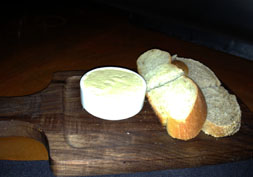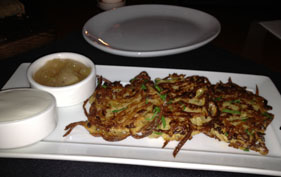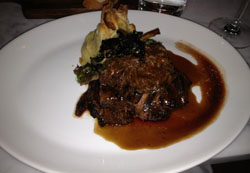Kutsher's Tribeca
 Tuesday, December 13, 2011 at 11:35AM
Tuesday, December 13, 2011 at 11:35AM Note: It should surprise absolutely no one that Kutsher’s Tribeca closed in mid-2014. This is, after all, a Jeffrey Chodorow restaurant. Quick failure is his calling card. A branch of Almond is expected to replace it. The review below was under the opening chef, Mark Spanganthal, who left the restaurant in early 2013.
*
 When I heard that Jeffrey Chodorow, the prolific creator of failed restaurants, was opening a “Catskills Jewish” place in Tribeca, I thought: Mr. Gimmick has struck again. The idea seemed patently absurd.
When I heard that Jeffrey Chodorow, the prolific creator of failed restaurants, was opening a “Catskills Jewish” place in Tribeca, I thought: Mr. Gimmick has struck again. The idea seemed patently absurd.
Kutsher’s Tribeca isn’t absurd at all. It’s actually kinda fun, and the food isn’t bad. The Chod’s role is minimized: he’s an investor, leaving the running of the place to Zach Kutsher, a fourth-generation descendant of the family behind the eponymous Kutsher’s Resort and Country Club in Monticello, New York.
Zach Kutscher is an earnest and sincere fellow (nothing like the Chod), and you want only the best for him, but it is not quite clear how they’ll make it work. There are 167 seats to fill, in a huge space where Drew Nieporent failed twice, most recently with Mai House.
 The popularity of the so-called Catskills Jewish cuisine is long past a zenith reached decades ago. The region was once considered a prime summer vacation spot for Jews, but it went into a long decline after the 1950s, owing to the three A’s: assimilation, airplanes, and air conditioning. Most of the resorts are now abandoned, no longer Jewish, or are run as summer camps for the ultra-orthodox.
The popularity of the so-called Catskills Jewish cuisine is long past a zenith reached decades ago. The region was once considered a prime summer vacation spot for Jews, but it went into a long decline after the 1950s, owing to the three A’s: assimilation, airplanes, and air conditioning. Most of the resorts are now abandoned, no longer Jewish, or are run as summer camps for the ultra-orthodox.
Kutsher’s, in fact, is the last kosher resort in the Catskills still operating year-round—but just barely. A couple of years ago, Mark and Helen Kutsher were ready to shut down after years of declining business. They got a reprieve when Yossi Zablocki, a lawyer from New Jersey, took over the place and injected much-needed capital. But the resort is still in poor shape, suffering from decades of under-investment. Many of the reviews on various travel sites are downright terrible. If Zablocki hopes to recapture the glory, he will have his work cut out for him.
I never visited Kutsher’s, but my girlfriend did. She even worked there one summer. She says Kutsher’s Tribeca doesn’t resemble the Catskills place at all. I don’t know what a modern version of Catskills décor would look like, but this ain’t it. But it’s pleasant enough, bedecked in bright blonde woods and soft banquettes. There’s a slightly over-loud, but inoffensive soundtrack that, like the décor, could be found anywhere. Should Kutsher’s fail, Chodorow could install his next gimmick with a minimum amount of retooling. Indeed, this must be the plan at any Chodorow establishment, given that they fail at around a 75 percent clip.
If you’re Jewish, you’ll recognize a lot of the menu: charoset, knishes, latkes, gefilte fish, matzo ball soup, potato kugel, chopped liver. Most of these are re-interpreted, served not quite the way you remember them. There’s no traif, but the restaurant is not kosher. Chef Mark Spangenthal adds a handful of neutral items like tuna crudo, beet and goat cheese salad, grilled duck breast, and the Creekstone Farms bone-in ribeye for two that mysteriously finds its way onto every menu in town, regardless of cuisine. These dishes are like the maroon sweater in your closet: they go with everything.
To me, this menu has a great nostalgic appeal. It remains to be seen how it will play to non-Jewish diners. There is something slightly comical when you hear an obviously non-Jewish bartender say, “I just love the kreplach.” Really?


The bread service (above left) was somewhat perfunctory, but I appreciated the soft butter. The Crispy Potato Latkes ($9; above right) with apple compote and sour cream were slightly less hearty versions of the ones I remember from childhood.
For $18, you can get the latkes topped with caviar, an absurdity that has Chodorow’s fingerprints all over it. How good can nine-dollar caviar be? For photos of this monstrosity, have a look at Gael Greene’s blog.


My girlfriend had the Matzo Ball Soup ($11; above left), which she said was terrific.
On the bartender’s recommendation, I decided to take a chance on the Gefilte Fish ($12; above right). This was a considerable risk, as the traditional version is the most vile concoction legal for human consumption: “a tan lump sitting in goo,” as Chef Spangenthal explains. The last time I tried it, I nearly gagged.
So Spangenthal set out to make a modern version that was…edible. For the usual mixture of pike, whitefish, and carp, floating in a jellied broth, he substituted sushi-grade halibut, bound with challah crumbs, beets, and horseradish. No jellied goo. He spent two months refining the dish. (There’s a longer explanation in New York.)
The good news is: he succeeded. This gefilte fish is actually enjoyable. I do wonder, though, how much appeal it’ll have for those who don’t have a nearly-inedible precursor to compare it to.
 The Delicatessen ($16; left) came with three meats. Pastrami had a delicious smokey flavor (though not as good as Katz’s), but it was offset by listless veal tongue. The chopped liver was excellent.
The Delicatessen ($16; left) came with three meats. Pastrami had a delicious smokey flavor (though not as good as Katz’s), but it was offset by listless veal tongue. The chopped liver was excellent.
 I wasn’t able to properly enjoy the Romanian Steak ($26; right), as we had over-ordered. Whether Romanian Jews ever had steak like this is an open question. I was expecting something more like the flat strip served at Sammy’s. This version was sliced and served in a mound, topped with caramelized onions. The beef was cooked to a bright medium rare, and unlike Sammy’s, it was prime and without gristle. A mushroom knish on the side was rather dull.
I wasn’t able to properly enjoy the Romanian Steak ($26; right), as we had over-ordered. Whether Romanian Jews ever had steak like this is an open question. I was expecting something more like the flat strip served at Sammy’s. This version was sliced and served in a mound, topped with caramelized onions. The beef was cooked to a bright medium rare, and unlike Sammy’s, it was prime and without gristle. A mushroom knish on the side was rather dull.
 We were too full for dessert; the meal ended with a packet of “Rabbi Mints” (left), the Catskills alternative to petits fours.
We were too full for dessert; the meal ended with a packet of “Rabbi Mints” (left), the Catskills alternative to petits fours.
There are no traditional Jewish wines worth serving at such a restaurant, so the wine list here is a generic mix that could be served anywhere: once again, the Chod protects himself against failure.
The cocktails (all $12) have witty names, like “Bug Juice” and “Bungalow Bunny.” Bug Juice is better remembered in the non-alcoholic version of your youth. Try the Milton’s Mark (Maker’s Mark, sweet vermouth, maple syrup, Amargo pisco bitters).
The staff is knowledgeable about the menu and reasonably attentive. The relentless upselling for which Chodorow’s restaurants are so well known, is held mostly in check.
The dining room was about 2/3rds full by 8:00 p.m. The question for Kutsher’s Tribeca is how many of those guests will want to return. Will this be a go-to restaurant, or a gimmick to try once? The answer to that question will determine whether Kutsher’s is still on the scene a couple of years from now.
Kutsher’s Tribeca (186 Franklin St. between Greenwich & Hudson Sts, Tribeca)
Food: ★
Service: ★
Ambiance: ★
Overall: ★



Reader Comments